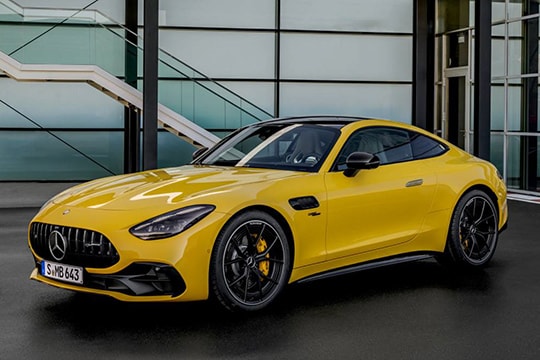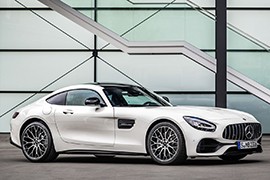MERCEDES-AMG GT Coupe Models/Series Timeline, Specifications & Photos
First production year: 2015
Engines: Plug-in hybrid, Gasoline
Mercedes-AMG introduced a new base model for its GT lineup in 2024 for the 2025 model year when it unveiled the 43 Coupe version of this lineup by installing an inline-four turbocharged engine in the car’s hood.
The Affalterbach-based company considered downsizing a bit when it introduced the GT 43 Coupe version in its lineup. To do that, it took the hand-built four-banger designed for the A 45 S and dropped it inside the engine bay of a GT. While the match looked unusual for a brand that used to have a punchy turbocharged V12 powerplant, it was actually a good thing for the automaker. The end result was a vehicle capable enough to outrun many sportscars on the market. Furthermore, it wasn’t difficult to create the vehicle since it already had the engine, the transmission, and the platform already developed.
Mercedes-AMG tried to differentiate the look of its lower-priced 43 Coupe from its higher-powered siblings, such as the GT 55 or the 63 versions. As a result, the coupe had a new front fascia that featured a Panamericana-style grille, like its brothers, but a different apron. Instead of side-mounted slim vertical scoops, it sported a broad lower air intake flanked by the air intakes that cooled the front brakes. Still, the automaker fitted the vehicle with the same headlights featuring three LED lines as daytime running lights.
The automaker designed new front fenders for the GT 43 Coupe. These featured horizontal vents behind the wheel arches. Moving on to the sides, the automaker offered an option for black side sills included. Both front and rear fenders were narrower than on the rest of the range. Still, the overall look of the vehicle retained the main characteristics of a grand tourer: a long hood, a short greenhouse, and a sloped back. The car rode on 19-inch alloy wheels, with an option for a 20- or 21-inch set. An EASY PACK tailgate that included a hands-free operated tailgate was available. Out back, the GT 43 featured an integrated rear spoiler that could raise and lower depending on the car’s needs. It was part of an active aerodynamic package that also included a set of flaps hidden behind the front grille. Out back, Mercedes-AMG fitted the 2025 GT 43 with two twin exhausts that flanked an active diffuser.
Inside, the coupe boasted a 2+2 configuration, with sports seats wrapped in Nappa leather at the front and a bench seat for two in the back. As an option, customers could get the vehicle with AMG Performance seats with integrated headrests and higher bolstered areas. Fronting the driver was a digital instrument panel integrated into a three-dimensional visor. The center console housed an 11.9-inch touchscreen installed in portrait mode, featuring an MBUX infotainment system. It offered extensive AMG-specific content in five display styles.
Mercedes-AMG installed an inline-four turbocharged powerplant carried over from the A 45 S model. Despite its two-liter displacement, this unit provided 421 PS (416 hp) to the rear wheels via a SPEEDSHIFT 9-speed automatic transmission with a wet-clutch system. A belt-driven starter generator provided an additional 10 kW (13 hp) for a short period of time. As a result, the 43 Coupe could rocket from 0 to 62 mph (0-100 kph) in 4.6 seconds on its way to a top speed of 174 mph (280 kph).
Mercedes-AMG unveiled the second generation of the GT lineup in 2023 but waited until the 2024 Chinese Grand Prix to unveil the mighty GT63 S AMG E Performance.
The German automaker tried to attract more customers from other well-known sports car brands when it unveiled the GT63 AMG S E Performance at the 2024 Chinese Grand Prix. It promised that the two-door GT could do what many supercars couldn’t, and it could do that while still providing a 2+2 seating configuration. Furthermore, the comfort level rivaled that of many other GT vehicles since it inherited the technology of other Mercedes-Benz cars. At the same time, the GT63 S E Performance featured an electric motor that powered the rear wheels to improve performance and lower emissions. Interestingly, the automaker offered the GT63 S E Performance as a plug-in hybrid, even though the car could be charged only at slow-speed chargers.
The 2025 Mercedes-AMG GT63 S E Performance was part of the C192 generation of the model and featured a broad grille at the front where the three-pointed star badge took center stage. In addition, the automaker adorned the massive air intake with twelve vertical double slats. Lower, on the apron, the car sported a slim A-shaped air intake flanked by vertical scoops that channeled air around the bodywork to lower the drag resistance.
From its profile, the 2025 GT63 S E Performance boasted a GT-like silhouette. Its front fenders featured oblique vents behind the wheel arches and the V8 Biturbo E Performance badges, available in black, as an option. The car kept the main attributes of a grand tourer: a long hood, a short and sloped-down greenhouse, and a short deck behind the rear window. Unlike its lesser-powered siblings, the flagship version of the GT Coupe rode on 20-inch light alloy wheels with a ten-spoke design, which Mercedes-AMG wrapped with 295/35 tires up front and 305/35 ones in the back. As an option, the automaker offered a 21-inch set. The active aerodynamic system of the vehicle also included a retractable wing on the deck, which could be manually or automatically deployed. Out back, under the bumper, the car manufacturer placed twin rectangular exhausts on each side of the rear diffuser.
The 2+2 configuration of the vehicle made it stand apart from many other sports cars. Its leather-wrapped cabin provided a luxurious ambiance, but thanks to the sports seats up front, it also breathed a sporty feeling. As an option, customers could get AMG Performance seats with integrated headrests. The automaker installed a TFT display in front of the driver that showed significant information about the car’s status, including specific data about the hybrid system. Furthermore, on the center stack, the C192 featured an 11.9-inch touchscreen for the MBUX infotainment system.
Under its skin, the 2025 Mercedes-AMG GT63 S E Performance featured a 4.0-liter bi-turbo engine up front and an electric motor on the rear axle. Their combined power was 816 PS (805 hp), from which 204 PS (201 hp) came from the electron-powered one. That was fed by a 600-volt, 6.1 kWh battery pack consisting of 560 liquid-cooled cells. They could provide an EV range of 13 km (8 miles). However, the automaker didn’t put them there to lower fuel consumption but to get better performance.
Mercedes-AMG GT63 S AMG E Performance 4.0L V8 Biturbo 9AT AWD (805 HP)
In the summer of 2023, Mercedes-AMG launched the second generation of one of the most famous products, the GT Coupe. The automaker introduced this nameplate in 2014 and kept it alive until 2023. But after nine years and around 18,900 units sold, the model needed a much-deserved retirement paving the way for the new generation, the C192.
The 2024 GT Coupe shared its underpinnings with the 2024 Mercedes-Benz SL, but everything else was different. At the front, the car featured the Panamericana grille specific for vehicles built in Affalterbach. It was flanked by functional side scoops that channeled the air from the front of the vehicle to the front discs to cool them. In addition, they created an air curtain that lowered the drag resistance. On the flared front fenders, behind the wheels, the car manufacturer installed extracting vents. The hood boasted two power domes that reflected the V-shaped engine underneath it. Since Mercedes-AMG built the GT Coupe as a grand tourer, it carefully crafted the greenhouse with a raked windshield followed by an arched roofline with an option for a panoramic glass roof. It was extended to the rear by a sloped windscreen mounted on the tailgate. The car sported a wing at the back that added downforce to the vehicle at higher speeds. The rear fascia was adorned by a set of elliptic-shaped taillights connected by a light strip. Under the bumper, the GT Coupe featured a wide diffuser that incorporated four squared exhausts.
Inside, Mercedes-AMG installed a 2+2 cabin layout suitable for four occupants. While the front sports seats provided enough comfort for long journeys, the rear ones were suitable just for persons up to 1.5 meters (4.9 feet) tall. Still, these were flat-folding, thus expanding the trunk space. The car manufacturer focused more on the driver's seat and installed a thick, three-spoke steering wheel filled with touch buttons and additional controls. Inside the instrument cluster, Mercedes-AMG placed a 3D display for main information about driving conditions. In addition, an 11.9" touchscreen for the MBUX infotainment unit provided all the necessary features and controls for the sat-nav, telephone, and sound system.
But, just like any other performance car produced by Mercedes-AMG, the most significant part was hidden under the vehicle's skin. The automaker offered the GT Coupe in two versions: the GT 55 4Matic+ and the GT 63 4Matic+. It was the first time in the model's history that it was available exclusively with an all-wheel-drive system. Both versions shared the same 4.0-liter V8 power plant, helped by a pair of turbochargers placed between the cylinder banks (hot-V). Like in any other AMG vehicle, these engines were hand built and signed by a single engineer. Mercedes-AMG was famous for its "One Man, One Engine" policy. Power went into all corners via a 9-speed (dual-clutch) gearbox fitted with a wet starting clutch to protect the drivetrain.
Since the separation of the AMG from the regular Mercedes-Benz models, the Affalterbach motorsport division started to offer faster cars for its customers. The GT was one of its most important models.
In 2014, AMG launched its first product that was named AMG instead of Mercedes-Benz AMG. It was a car like no other in the Mercedes-Benz manufacturer lineup. The supercar was offered with the most powerful naturally aspirated engine on the market, at the time of its launch. In 2017 came the first facelift and, three years later, a new refresh for the lineup was introduced.
The 2020 model featured some exterior changes to enhance the look and the car's aerodynamic. The full-LED headlights became a standard feature and a new grille design was installed. The front bumper was divided into three main areas: the lower grille and the side-intakes. The latter was split in two by a horizontal slat. The back of the car was slightly improved, but the four exhaust pipes were left visible, poking out through the rear apron.
The interior featured a carbon-fiber trim on the center console and the dashboard. The instrument cluster was completely digital, with a 12.3” TFT color-display. An additional screen was placed on top of the center stack, for the infotainment system. It was controlled via voice commands, a touch-pad, or via the 10.3” touch-screen. The Apple CarPlay and the Android Auto integration was fitted as standard.
The 2020 AMG GT featured a twin-turbo V8 engine that offered 469 hp. The GT C variant received 550 hp and the top-spec GT R and GT R Pro received the 577 hp unit. All versions were paired to a 7-speed, dual-clutch, automatic transmission. Power went to the rear wheels and the gearbox was mounted in the back.
When the AMG started its way as a different brand than the Mercedes-Benz, it had to offer some completely different cars, and the 2018 GT Coupe GT-R was a good example.
The AMG GT-R didn't share its bodywork with any Mercedes-Benz model. It was an AMG only vehicle and the car that showed a clear line of approach, or departure, from the classy, comfortable, Mercedes-Benz brand. It was a car that was a fierce competitor for cars like the Porsche 911.
The GT-R design was enhanced for a better aerodynamic. The redesigned front apron was fitted with two clear-coated carbon-fiber flics at the sides. The headlights had an unusual design, with a larger LED for the high/low beam and an additional three LED-lights for the turn-signal, daytime running lights, and the directional light for cornering, also known as navigation light. In the rear, the new LED taillights looked better on the dark background.
Inside there was a cockpit for two, with full digital display for the instrument cluster and an additional display for the infotainment unit. The latter was fitted as standard with the AMG TRACK PACE that detects the track and stores the information regarding acceleration, braking point and delivers detailed data for the driver, so the lap-times can be improved. Some famous tracks are already stored on the internal hard-drive, but the other tracks can be recorded by the driver.
The AMG GT-R featured different settings for the engine, transmission, and suspension to optimize the track performance, or just for daily driving, when the AMG SPEEDSHIFT MCT 7 can shift smoothly and the 4.0-liter V8 will run lower on the rpm scale, with a deeper sound note.
There are so many letters to name a car that, in fact, is a race car with number plates on it. We heard that before many times, but this is serious. The amount of carbon-fiber used for this vehicle is far beyond a lot of other sports cars.
The limited-edition Mercedes-AMG GT R PRO had a further improved driving dynamics, in particular on the racetrack. The experience gained from the AMG GT3 and AMG GT4 racing cars was influential in its development. The improvements from motorsport can be clustered in four areas: suspension, lightweight construction, aerodynamics and appearance.
Every aerodynamic detail is functional: from the front and rear splitter to the air-extracting vents on the front fenders and the adjustable wing. Every detail is fully functional.
The suspension can be adjusted in stiffness and height, the brakes are carbo-ceramic and inside, behind the fixed carbon-fiber seats, there is a roll-cage. Underneath the car, there are some shields and carbon-fiber parts to stiffen the bodywork even more. The front anti-roll bar is made out of carbon-fiber and it is adjustable. The rear one was kept as steel, to balance the vehicle. That is also adjustable. The roof is carbon fiber, not for the stiffer body but to reduce weight, especially on the upper part of the vehicle. This car is not made for shopping, but for lapping race-tracks. It even comes with its own fire-extinguisher!
Even if it wasn't a completely new model, the 2019 AMG GT Coupe featured enough changes to impress the market after 5 years of it was introduced.
The sport and supercar GT from AMG has received some serious improvements on the 2019 refresh. The AMG engineers and its marketing department checked all the boxes with aerodynamic improvements, interior upgrades and, of course, more power and torque.
From the outside, there is a new grille on the front, inspired by the original Mercedes-Benz "Gullwing" from the '50s. On the bottom of the bumper, an active aerodynamic system was installed, to help heat-up and cool the engine. On the side, the same big air-extractors on the front fenders were installed and those were not only for design purposes.
Inside, the big center console kept that special design with 8 buttons installed on a large V-shaped design. Of course, it corresponded to the V8 engine idea. The sport-bucket seats received new materials and color options and, for the driver, the full digital instrument cluster display was fitted as standard. Moreover, the AMG TRACK PACE was standard for the COMAND online infotainment system.
While the 2015 AMG GT offered 462 hp, the 2019 GT output was increased to 522 hp. That was more than the 2015 AMG GT S had. That extra power was sent to the rear wheels via a 7-speed SPEEDSHIFT AMG automatic transmission.
Mercedes-AMG celebrated its 50th Anniversary in 2017 and with that occasion improved or subtly upgraded its entire range, and the GT S coupe was also affected, in a positive way.
For the 2018 model year, the GT S received a redesigned front grille with the Panamericana styling, consisting of 15 vertical double-slats. Those in the middle supported the big three-pointed-star badge. Also, the bumper was redesigned with larger exterior air-inlets and the A-shaped lower grille in the apron. A black glossy trim adorned the bottom of the spoiler at the front. On the sides, the air vents placed on the front fenders got the chromed V8 Biturbo lettering on the black horizontal slats. At the back, the car sported dual exhausts integrated into the rear diffuser, also painted in black. Moreover, the Carbon-Fiber styling package was extended for the side skirts and the rear apron.
Inside, the carmaker installed sport bucket seats with Alcantara upholstery that provided excellent side support during hard cornering. The driver was spoiled with a three-spoke, flat-bottom steering wheel covered in the same material as the seats. A pair of aluminum shift paddles found their way at the tip of the driver's fingers.
But the most important upgrades were for the technical department. The rear axle received a standard limited-slip differential integrated into the transmission housing, increasing the cornering speed. The V8 powerplant received a retune, which brought 12 more hp (9kW) for the GT S version, and it was mated to the seven-speed AMG Speedshift automatic (dual-clutch) gearbox.
AMG celebrated 50 years of existence in 2017 when it launched the GT C Coupe, a hardtop version of the GT C Roadster introduced in 2016.
Placed between the GT and the mighty GT R, the GT C coupe was also offered as a “50th Anniversary” edition. It tried to be a daily sportscar, although its performance placed it closer to the supercar territory. Based on what Mercedes-Benz knew about comfort and what the AMG was capable of, the result was a near-perfect blend. It could be just a boulevard cruiser in the soft-suspension setting or a beast on the track when it pulled out its gloves in the “Track” mode.
Its front fascia revealed the Panamericana grille flanked by the angry headlights fitted with DRL/blinkers on their inner sides. On the lower bumper, the car manufacturer installed a second grille that helped to cool the intercoolers and a pair of side scoops crossed by a horizontal slat. From its profile, behind the front wheel wells, AMG installed vents with a black mesh adorned with the chromed V8 Biturbo badges. The greenhouse sported a sloped-down tailgate towards the back of the car. Finally, the rear fascia sported slim taillights, and under the bumper was a pair of rectangular exhausts that flanked the diffuser.
Inside the GT C, customers found a sporty yet luxurious cabin fitted with high-bolstered bucket seats at the front, divided by a tall center console. This hosted the buttons for the transmission and the controller for the infotainment unit. The driver fronted a flat-bottom steering wheel and a minimalist instrument cluster filled with two large dials for the speedometer and tachometer that flanked a TFT display between them.
Underneath the long hood, Mercedes-AMG installed a hand-built twin-turbocharged V8 mounted almost completely behind the front axle. Since the gearbox was mounted on the rear axle to help with weight distribution, the automaker installed a drive shaft from the engine to that.
Mercedes-Benz unveiled the facelifted version of its AMG GT coupe at the 2017 North American Motor Show, and it was the queen of the show.
When Mercedes-Benz decided to create a separate brand for the AMG division, it agreed that the new brand would have specific models. The GT was the beginning, and, in 2014, it was a blast, and its sound thrilled everyone and petrolheads on both sides of the Atlantic to shiver. It's front mid-engine concept with transaxle, and the intelligent aluminum lightweight construction formed the basis for a highly dynamic driving experience. Its likewise newly developed AMG 4.0-liter V8 bi-turbo engine underscored the hallmark AMG driving performance.
The facelifted version kept the same original elements from the 2014 model but added a new image with a Panamericana grille with 15 vertical slats. The new front bumper emphasized the car's width, making it visually sit lower to the road. The large outer air inlets provided enough air to cool the engine. The carmaker installed vertical louvers that opened or closed at the bottom of the front bumper, depending on the engine heat management system.
At the same time, the two-seater was a straightforward, comfortable, and reliable companion for everyday motoring thanks to its practical tailgate, easily accessible luggage compartment, high level of comfort on long journeys, and the extensive Mercedes-Benz Intelligent Drive assistance systems. It was designed and built as a Gran Tourer car and excelled in that.
Under the hood, the AMG engineers found a way to provide more power from the 4.0-liter twin-turbocharged gasoline engine. It was paired as standard to a 7-speed automatic (dual-clutch) gearbox.
Mercedes-AMG came on the market with an even meaner machine in 2016, launching the GTR version for the C190 lineup, and it broke records.
Usually, AMGs were sportier versions of Mercedes-Benz luxury cars. Even though they offered quite a punch, they were not designed for records on tracks. They kept their comfortable seats and suspensions and their luxurious cabins. But when AMG became a stand-alone brand, things changed quickly, and the GTR proved that.
Based on the same platform as the Mercedes-Benz SL (R232), the GTR came as a higher-spec version of the regular GT that was launched in 2015. But, unlike that, it featured a Panamericana front grille with vertical slats and a different apron on the lower bumper, with broad air intakes. From its profile, the GTR kept the same roofline with a sloped- rear window. In addition, at the back, a massive wing was mounted on the trunk lid. Finally, on the lower bumper, the car sported a set of Venturi tubes that enhanced the ground effect, sucking the vehicle onto the ground at high speeds.
The cabin was a mix of luxury and sportiness with its sports bucket seats. The automaker extensively used Alcantara and leather for wrapping the interior. At the same time, the dashboard featured a display atop the center stack for the infotainment system and an analog instrument panel.
Under the hood, AMG installed a hand-built hot V8 powerplant with two superchargers inside the cylinder banks. It was tuned to provide 585 PS (577 hp). That was more than 100 ponies than its regular GT sibling. As an ultimate statement, the GTR established a lap record around the Nurburgring for an RWD vehicle at the time of its launch.
Mercedes-AMG focused on its own lineup with models that didn’t have a Mercedes-Benz equivalent, and the GT lineup that it introduced in the Fall of 2014 at the Paris Motor Show confirmed it.
Despite being known as a luxury car maker, Mercedes-Benz was known for several famous race cars. Moreover, it’s one of the European automakers that started the horsepower war with the 1991 E500. So, it was not a stranger to the high-performance automotive segment. Then, in 1999, it became the major investor in the AMG specialist manufacturer that tuned and produced high-performance versions of Mercedes-Benz vehicles. Eventually, the AMG became a separate brand, and the 2015 GT (C190) was among its most important creations. Even if it shared some parts with other Mercedes-Benz vehicles, it was the kind of supercar where the luxurious features were placed second.
The car’s exterior was penned by the Slovenian designer Robert Lesnik, who previously worked for Volkswagen. For the C190, he took inspiration from the famous Mercedes-Benz SL “Gullwing” from the ‘50s. As a result, the 2015 GT featured a low and flat hood adorned by two longitudinal power domes, suggesting that there was a V engine underneath it. It was flanked by LED High-Performance headlights that sported eyebrow-like daytime running lights. The main grille was wide and featured a single horizontal slat and a 3D mesh design, while the lower bumper had the AMG-specific A-shaped design flanked by two functional side scoops. From its profile, the vents behind the front wheels’ wheel arches resembled those from the legendary 1955 300 SLR. Still, the doors were front-hinged, and the greenhouse was sloped down. A tailgate with a wide opening eased access to the unusually large trunk for a supercar. Last but not least, a retractable wing was neatly concealed by the metallic part of the tailgate.
Inside, the automaker made a mix of sports-oriented details and luxurious features and amenities fit for a three-pointed-star vehicle. There were just two seats in the cabin, separated by a tall center console where the automaker placed two cup holders and a storage area concealed under the armrest. On the dashboard, the automaker installed round vents that resembled those from the original 1954 SL, and atop the center stack, it placed the screen for the infotainment system that could be controlled via a rotary knob and several buttons housed on the center console. The high-bolstered seats provided excellent side support to keep their occupants in place during high-speed cornering situations.
Under the hood, AMG installed a handcrafted V8 powerplant twin-turbocharged. It sent all its oomph to the rear wheels via a seven-speed automatic (dual-clutch) gearbox. In addition, the automaker also added a limited-slip differential to keep things under control.
The Mercedes-AMG division became a separate brand and showed its muscles in 2014 when it revealed the AMG GT Coupe, built for excitement.
After years of marching under the same brand, Mercedes-Benz decided that it was time for AMG to evolve on a different path. Its products were designed for speed and performance, which were completely different than other Mercedes-Benz products. That's why when AMG designed the GT from scratch, it made it completely different than any other three-pointed-star product.
With its long hood, short cabin, and sloped rear end, the AMG GT was one of the few cars ever built to feature a front-mid-engine construction. Apart from the badge on the broad grille, there was no connection with the Mercedes-Benz brand. On the front fenders, a set of air-vents released the air trapped in the wheel wells to increase the downforce. It was the same styling and practical idea used for the legendary SL "Gullwing."
Inside, the two-seat cockpit was separated into two areas by the tall center console. At the same time, the two-seater was a straightforward, comfortable, and reliable companion for everyday motoring thanks to its practical tailgate, easily accessible luggage compartment, high level of comfort on long journeys, and the extensive Mercedes-Benz Intelligent Drive assistance systems. The interior sported a central aviation theme, with many air vents, a wing-like dashboard and a tall center stack inspired from motor racing. High-quality materials and precision finished surfaces helped create a luxurious yet sporty feeling.
The AMG GT is also the first sports car fitted with a "hot inside V" engine and dry-sump lubrication. Its turbochargers were installed between the two cylinder banks to reduce the turbo-lag.












